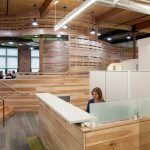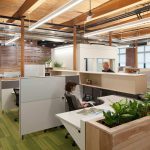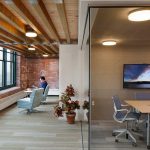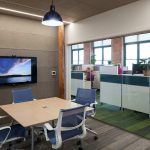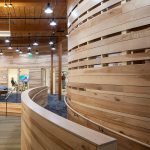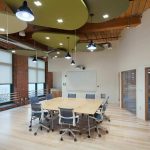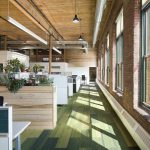Office Fit-Up, The Nature Conservancy In Maine
Project Name
This project included a complete interior renovation and fit-up of approximately 8,800 square feet of existing space and a new 600 square foot mezzanine, within the historic Fort Andross Mill Business Center alongside the Androscoggin River, in Brunswick, Maine. The project was completed in the spring of 2017.
Our client requested an office space that fully reflects who they are as an organization. They wanted a space that attracts, supports and inspires their greatest asset – their talented and motivated staff, and a space that encourages collaboration. Their Objectives included creating a space that supports staff well-being and productivity, models green and sustainable design, and inspires innovative and collaborative problem solving.
The project team (Architect, Engineer, and Sustainability Consultant) was selected to guide the project to meet the goals for LEED and WELL certifications. This is the first office in northern New England, and the first non-profit space in the Eastern United States to meet the requirements for WELL Building Standard™ certification, and the project has also been awarded LEED Gold certification.
The new space features natural and recycled elements that artfully reflect our client’s mission. The curving wood wall is made from yellow birch sustainably harvested from our client’s own certified forest property in the St. John River valley. The carpet tiles underfoot, with a pattern reminiscent of crashing surf, are made from recycled fishing nets in a partnership that cleans beaches and the ocean of nylon waste. The countertop in the kitchen/lounge was crafted using historic log-drive lumber salvaged from the bottom of the Penobscot River—a place where our client has played a major role in a historic river restoration project.
Before being renovated, the office space consisted of walled offices and high cubicles. The new space breaks down the barriers of hierarchy to provide equality, natural daylight and inspiring views for all. Workstations with partitions high enough for ample privacy, yet low enough to allow views to the exterior windows, occupy the open office areas, while glass walled conference rooms of varying size and flexible purpose float within the office space and provide privacy for meetings yet retaining ample natural light and views to the exterior.
Measure 1: Design for Integration
From the beginning our client had a strong goal of expressing their values of sustainability, social equity, and environmental stewardship in the design. We achieved this through our use of form, material, and workplace ecology. When one arrives, they are presented with a curved wall that is made from sustainably harvested yellow birch that undulates to mimic the river outside. It guides one past the conference rooms to the reception area where the majority of the office is then revealed. Private breakout spaces and conference rooms are pulled to the center leaving the perimeter open, providing ample natural daylight and views to the exterior for the workers. Great care was given to the occupant’s indoor air quality. We provided a balanced ERV system and specified extremely low emitting materials (Meeting LEED gold and WELL standards).
Measure 2: Community
The Nature Conservancy is intimately connected to its community through its constant outreach and cooperative work with land-owners, foresters, land trusts, donors, members, and environmental advocates. Wherever possible we sourced local materials often from lumber/forestry partners. Within the office itself there was a desire to foster a strong sense of community. This was achieved by creating equivalent work spaces (The executive director’s work space is identical to an intern’s). Incidental casual work spaces were created for a sense of comfort and mobility. Private “phone booth” spaces were created for private calls and nursing infants. The Kitchen and dining space was given one of the best locations in the office. It was recognized that this was probably the place where the greatest socialization of the office would occur. To help foster a positive connection between workers, ample fenestration was provided giving the workers a stunning view of the river as it tumbles over the falls. A large “social counter” made from the risen logs that had sunk over a hundred years ago when the river was their primary transport to the mill.
Measure 3: Ecology
As this is a tenant fit-up project (interior only) it has no impact on the immediate ecosystem, habitats, or biodiversity other than generally improving energy consumption (greenhouse gas emissions) and water consumption.
Measure 4: Design for water
As a WELL project, the potable water was tested for inorgani, organic, and agricultural contaminants. It was also tested for levels of disinfectants, disinfectant biproducts, and fluoride. All of which tested well within the WELL building standard requirements.
As a LEED project, all fixtures chosen were low-flow Watersense rated fixtures. This was enough to earn the project a full eleven points (the maximum) in the water efficiency category for water use reduction of over 30%.
Measure 5: Design for Economy
Budget was a concern through the entire project. The project team worked tirelessly to evaluate and determine cost effective ways to implement the design intentions without compromising on the mission for sustainability, energy efficiency and a space that inspires innovative and collaborative problem solving. Alignments were created with product manufacturers and venders that had sustainability and health and wellbeing as a focus, with preference given to local Maine companies. The space was constructed for approximately $125 per square foot.
Measure 6: Design for Energy
Great attention was given to the project’s energy consumption. Being an interior rented space in a historic load-bearing brick building there was very little that could be done to the exterior envelope (except for added insulation to the roof. Even so, our design team focused on Daylighting controls, Light power density, Efficient energy recovery ventilation systems, interior storm windows, and roof insulation. Working with our sustainability consultant we determined that the EUI of the project was reduced by 29% coming in at 35 kBtu/sf-yr.
Measure 7: Design for Wellness
As a WELL certified project, occupant wellness was a primary focus of the design. As such, the WELL Building institute has verified that the space excels at providing superior indoor air quality, water quality, Light, and that provisions have been made by the design, implementation of the design, and operation of the space to provide superior nourishment, fitness, equity, and wellness of mind.
Measure 8: Design for Resources
Wherever possible the project uses locally sourced, low embodied energy, high recycled content, materials. All structural framing in the project is FSC certified. All clear finished wood (apart from the furniture) is locally harvested from the client’s own sustainably managed forests. The wood counters of the kitchen and breakroom are manufactured from sinker logs raised from the bottom of the Penobscot River. The Carpet is made from 100% recycled content with some of that being manufactured from salvaged fish nets. As a LEED Gold project, we have verified 40% of the materials used in the project qualify as “reused”. 75% of the Construction waste was diverted from disposal. More than 10% of all materials used are recycled, far more than 20% of the materials used were manufactured locally, and over 50% of all the wood used was FSC certified.
Measure 9: Design for Change
The space itself resides within a much greater structure called the “Fort Andross Building” It is also called the Cabot Mill Building. The Cabot Mill (primarily a cotton textile mill) was built at the location of the original Fort Andross that was torn down before 1700. This structure is a model of adaptability and change. Within the structure are many offices, an antique store, a radio station, and a restaurant.
With this project improvements were made to the long-term benefit of the greater building. An Agreement was made with the owner of the greater building to install and purchase power from a large solar array mounted on the roof. This array provides a substantial amount of energy to offset the usage from the Nature Conservancy’s plug loads. One day the Nature Conservancy could leave that space for a different location. If it did so it would leave a much-improved space behind for the next tenants no matter what their use might be. The ventilation system is vastly improved, the heating and cooling systems are also far more efficient, and the solar panels provided on the roof top will remain with the building, benefiting all the tenants in the Mill.
Measure 10: Design for Discovery
Throughout the design process we worked with our sustainability consultant and an organizational ecologist to interview current staff and design a space that meets their individual needs and interests yet allows for growth and stronger communication, creativity and productivity. Throughout construction, we continued to work with the staff to educate and prepare them for the changes in the design and organization of their space, along with required changes in habits and works methods. Following construction, we have met with staff and had informal chats to understand what’s working and what’s not working, to understand how people are using the office and to understand the changes in communication, creativity and productivity.
The new office has been tested by a 3rd party company and found to meet all the requirements for both LEED and WELL. In the upcoming months our team is planning to present what we have learned throughout the process regarding biophilic design and organizational ecology.



